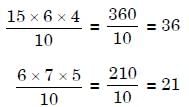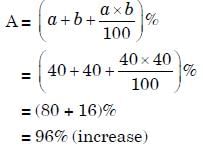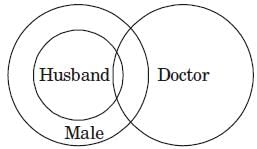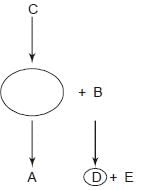All Exams >
Class 10 >
NTSE for Class 10 >
All Questions
All questions of Delhi for Class 10 Exam
What will be the difference between simple interest and compound interest on sum of Rs 6000 in 2 years at the rate of interest of 5% p.a.- a)Rs 15
- b)Rs 20
- c)Rs 30
- d)Rs 10
Correct answer is option 'A'. Can you explain this answer?
What will be the difference between simple interest and compound interest on sum of Rs 6000 in 2 years at the rate of interest of 5% p.a.
a)
Rs 15
b)
Rs 20
c)
Rs 30
d)
Rs 10
|
|
Ritu das answered |
Calculation of Simple Interest:
Simple Interest (SI) = P * R * T / 100
SI = 6000 * 5 * 2 / 100
SI = 6000 * 0.1
SI = Rs 600
Calculation of Compound Interest:
Compound Interest (CI) = P * (1 + R/100)^T - P
CI = 6000 * (1 + 5/100)^2 - 6000
CI = 6000 * (1.05)^2 - 6000
CI = 6000 * 1.1025 - 6000
CI = 6615 - 6000
CI = Rs 615
Difference between Compound Interest and Simple Interest:
Difference = CI - SI
Difference = Rs 615 - Rs 600
Difference = Rs 15
Therefore, the difference between compound interest and simple interest on a sum of Rs 6000 in 2 years at the rate of interest of 5% p.a. is Rs 15. The correct answer is option 'A'.
Simple Interest (SI) = P * R * T / 100
SI = 6000 * 5 * 2 / 100
SI = 6000 * 0.1
SI = Rs 600
Calculation of Compound Interest:
Compound Interest (CI) = P * (1 + R/100)^T - P
CI = 6000 * (1 + 5/100)^2 - 6000
CI = 6000 * (1.05)^2 - 6000
CI = 6000 * 1.1025 - 6000
CI = 6615 - 6000
CI = Rs 615
Difference between Compound Interest and Simple Interest:
Difference = CI - SI
Difference = Rs 615 - Rs 600
Difference = Rs 15
Therefore, the difference between compound interest and simple interest on a sum of Rs 6000 in 2 years at the rate of interest of 5% p.a. is Rs 15. The correct answer is option 'A'.
Parth can row 16 km downstream and 8 km upstream in 6 hours. He can row 6 km upstream and 24 km downstream in 6 hours. Find the speed of Parth in still water- a)5 km/hr
- b)3 km/hr
- c)6 km/hr
- d)8 km/hr
Correct answer is option 'A'. Can you explain this answer?
Parth can row 16 km downstream and 8 km upstream in 6 hours. He can row 6 km upstream and 24 km downstream in 6 hours. Find the speed of Parth in still water
a)
5 km/hr
b)
3 km/hr
c)
6 km/hr
d)
8 km/hr
|
|
Ritu Saxena answered |
From given question


Solving equations (i ) and (i i ), we get
x = 1/8
y = 1/2
Now e + f = 8 {e represents Parth’s speed}
e – f = 2 {f represents speed of stream}
e – f = 2 {f represents speed of stream}
⇒ e = 5 km/hr
In a certain code
P stands for +
Q stands for –
R stands for ×
S stands for ÷
Then number corresponding to 6R8S1R3Q5P7Q4P2 is- a)144
- b)148
- c)146
- d)116
Correct answer is option 'A'. Can you explain this answer?
In a certain code
P stands for +
Q stands for –
R stands for ×
S stands for ÷
Then number corresponding to 6R8S1R3Q5P7Q4P2 is
P stands for +
Q stands for –
R stands for ×
S stands for ÷
Then number corresponding to 6R8S1R3Q5P7Q4P2 is
a)
144
b)
148
c)
146
d)
116
|
|
Ritu Saxena answered |
From the given code
= 6 × 8 ÷ 1 × 3 – 5 + 7 – 4 + 2
= 6 × 8 × 3 – 5 + 7 × 2 = 144
Vinod has some cows and some hens in his shed. The total number of legs is 92 and total number of heads is 29. Then the number of hens in his shed is- a)14
- b)12
- c)17
- d)21
Correct answer is option 'B'. Can you explain this answer?
Vinod has some cows and some hens in his shed. The total number of legs is 92 and total number of heads is 29. Then the number of hens in his shed is
a)
14
b)
12
c)
17
d)
21
|
|
Ritu Saxena answered |
Let the total number of hens be ‘x’.
∴ Total number of cows is (29 – x).
According to question
2x + 4(29 – x) = 92
2x + 116 – 4x = 92
∴ 2x = 24
∴ x = 24
Hence the number of hens is 24
If the sum of the digits of a two digit number is 9 and the difference between the number and that formed by reversing the digits is 45 then number is- a)81
- b)72
- c)45
- d)54
Correct answer is option 'B'. Can you explain this answer?
If the sum of the digits of a two digit number is 9 and the difference between the number and that formed by reversing the digits is 45 then number is
a)
81
b)
72
c)
45
d)
54
|
|
Ritu Saxena answered |
From given question
x + y = 9 ...(i )
(10x + y) – (10y + x) = 45
9 (x – y) = 45
x – y = 5 ...(ii )
Solving equations (i ) and (ii ), we get
∴ x = 7, y = 2
So the number
= 10x + y
= 10 x 7 + 2
= 72
∴ 72 is the number
If the first and third digits of each number are inter changed and one is added to the second digit of each number, then which of the following pairs of numbers, will have highest total of their numerical value?- a)946 and 728
- b)728 and 574
- c)669 and 946
- d)669 and 629
Correct answer is option 'D'. Can you explain this answer?
If the first and third digits of each number are inter changed and one is added to the second digit of each number, then which of the following pairs of numbers, will have highest total of their numerical value?
a)
946 and 728
b)
728 and 574
c)
669 and 946
d)
669 and 629
|
|
Ritu Saxena answered |
From option (1)
1. 659 and 837
From option (2)
2. 837 and 485
From option (3)
3. 976 and 659
From option (4)
4. 976 and 936
1. 659 and 837
From option (2)
2. 837 and 485
From option (3)
3. 976 and 659
From option (4)
4. 976 and 936
∴ Highest numerical value is 976 and 936
Looking into a mirror, the clock shows 9:30 as the time. The actual time is- a)2:30
- b)3:30
- c)4:30
- d)6:30
Correct answer is option 'A'. Can you explain this answer?
Looking into a mirror, the clock shows 9:30 as the time. The actual time is
a)
2:30
b)
3:30
c)
4:30
d)
6:30
|
|
Sarika bhatia answered |
Explanation:
Given:
- The clock in the mirror shows 9:30.
To find the actual time, we need to understand how clocks work and how they are reflected in a mirror.
How clocks work:
- A clock has two hands - an hour hand and a minute hand.
- The hour hand moves 12 times slower than the minute hand.
- The hour hand completes one full revolution in 12 hours, while the minute hand completes one full revolution in 60 minutes.
How clocks are reflected in a mirror:
- When we look at a clock in a mirror, the reflection is reversed horizontally.
- The hour hand appears to rotate in the opposite direction, but its speed remains the same.
- The minute hand appears to rotate in the same direction, but its speed remains the same.
Analysis:
- The clock in the mirror shows 9:30, which means that the minute hand is pointing at the 6 and the hour hand is pointing between the 9 and 10.
- Since the hour hand appears to rotate in the opposite direction in the mirror, we need to determine the position it would be in if it moved 12 times slower.
- If the mirror image of the hour hand is pointing between the 9 and 10, then the actual hour hand would be pointing between the 3 and 4.
Solution:
- The minute hand is pointing at the 6, indicating that it has completed 30 minutes.
- The hour hand is pointing between the 3 and 4, indicating that it has completed half of an hour.
- Since the hour hand moves 12 times slower, half an hour for the hour hand is equivalent to 6 hours on a normal clock.
- Therefore, the actual time is 6:30.
Conclusion:
The correct answer is option 'A' - 2:30, as the actual time is 6:30.
Given:
- The clock in the mirror shows 9:30.
To find the actual time, we need to understand how clocks work and how they are reflected in a mirror.
How clocks work:
- A clock has two hands - an hour hand and a minute hand.
- The hour hand moves 12 times slower than the minute hand.
- The hour hand completes one full revolution in 12 hours, while the minute hand completes one full revolution in 60 minutes.
How clocks are reflected in a mirror:
- When we look at a clock in a mirror, the reflection is reversed horizontally.
- The hour hand appears to rotate in the opposite direction, but its speed remains the same.
- The minute hand appears to rotate in the same direction, but its speed remains the same.
Analysis:
- The clock in the mirror shows 9:30, which means that the minute hand is pointing at the 6 and the hour hand is pointing between the 9 and 10.
- Since the hour hand appears to rotate in the opposite direction in the mirror, we need to determine the position it would be in if it moved 12 times slower.
- If the mirror image of the hour hand is pointing between the 9 and 10, then the actual hour hand would be pointing between the 3 and 4.
Solution:
- The minute hand is pointing at the 6, indicating that it has completed 30 minutes.
- The hour hand is pointing between the 3 and 4, indicating that it has completed half of an hour.
- Since the hour hand moves 12 times slower, half an hour for the hour hand is equivalent to 6 hours on a normal clock.
- Therefore, the actual time is 6:30.
Conclusion:
The correct answer is option 'A' - 2:30, as the actual time is 6:30.
If the first half of the English alphabet is reversed and so is the 2nd half, then which letter is7th to the right of the 12th letter from the left side?- a)S
- b)U
- c)R
- d)T
Correct answer is option 'B'. Can you explain this answer?
If the first half of the English alphabet is reversed and so is the 2nd half, then which letter is7th to the right of the 12th letter from the left side?
a)
S
b)
U
c)
R
d)
T
|
|
Sanjula dubey answered |
To solve this question, let's break it down step by step:
Step 1: Reverse the first half of the English alphabet
The first half of the English alphabet consists of the letters A to M. When we reverse these letters, we get the following sequence:
A becomes M
B becomes L
C becomes K
D becomes J
E becomes I
F becomes H
G becomes G
Step 2: Reverse the second half of the English alphabet
The second half of the English alphabet consists of the letters N to Z. When we reverse these letters, we get the following sequence:
N becomes Z
O becomes Y
P becomes X
Q becomes W
R becomes V
S becomes U
T becomes T
Step 3: Determine the 12th letter from the left side
Since we are counting from the left side, the 12th letter from the left side is L.
Step 4: Determine the letter that is 7th to the right of L
Starting from L, we count 7 letters to the right, taking into account the reversed alphabet sequence. The letters in this sequence are:
L, K, J, I, H, G, F
So, the letter that is 7th to the right of L is F.
Step 5: Identify the correct option
According to the given options, the correct letter is U, which matches the letter we found in step 4.
Therefore, the correct answer is option B) U.
Step 1: Reverse the first half of the English alphabet
The first half of the English alphabet consists of the letters A to M. When we reverse these letters, we get the following sequence:
A becomes M
B becomes L
C becomes K
D becomes J
E becomes I
F becomes H
G becomes G
Step 2: Reverse the second half of the English alphabet
The second half of the English alphabet consists of the letters N to Z. When we reverse these letters, we get the following sequence:
N becomes Z
O becomes Y
P becomes X
Q becomes W
R becomes V
S becomes U
T becomes T
Step 3: Determine the 12th letter from the left side
Since we are counting from the left side, the 12th letter from the left side is L.
Step 4: Determine the letter that is 7th to the right of L
Starting from L, we count 7 letters to the right, taking into account the reversed alphabet sequence. The letters in this sequence are:
L, K, J, I, H, G, F
So, the letter that is 7th to the right of L is F.
Step 5: Identify the correct option
According to the given options, the correct letter is U, which matches the letter we found in step 4.
Therefore, the correct answer is option B) U.
If x + y + z = 0, then value of
- a)x + 11
- b)y + 11
- c)z + 11
- d)10
Correct answer is option 'D'. Can you explain this answer?
If x + y + z = 0, then value of

a)
x + 11
b)
y + 11
c)
z + 11
d)
10

|
Shanu Siddiqui answered |
-z*-x*-y _ xyz is 11= -1+11 =10
If in a certain code language ‘THREAT’ is written as ‘RHTTAE’ then how will ‘PEARLY’ be written in that code?- a)YLRAEP
- b)YLRPAE
- c)AEPYLR
- d)AEPRYL
Correct answer is option 'C'. Can you explain this answer?
If in a certain code language ‘THREAT’ is written as ‘RHTTAE’ then how will ‘PEARLY’ be written in that code?
a)
YLRAEP
b)
YLRPAE
c)
AEPYLR
d)
AEPRYL
|
|
Ritu Saxena answered |

Logic : First half is reversed, then second half of reversed.
Direction: Read the following information carefully and answer the questions given below:M, P, J, B, R, T and F are sitting around a circle facing the centre. B is the third to the left of J who is second to the left of M. P isthird to the left of B and second to the right of R. T is not an immediate neighbour of M.Who is second to the left of T?- a)F
- b)M
- c)P
- d)J
Correct answer is option 'A'. Can you explain this answer?
Direction: Read the following information carefully and answer the questions given below:
M, P, J, B, R, T and F are sitting around a circle facing the centre. B is the third to the left of J who is second to the left of M. P isthird to the left of B and second to the right of R. T is not an immediate neighbour of M.
Who is second to the left of T?
a)
F
b)
M
c)
P
d)
J
|
|
Darshan kumar answered |
Understanding the Arrangement
To solve the problem, we need to arrange M, P, J, B, R, T, and F based on the provided clues.
Step-by-Step Arrangement
1. Position of J and B:
- J is seated such that B is the third to the left of J.
- This means if we place J at a position, B will occupy the position two places to the left of J.
2. Position of M:
- J is second to the left of M.
- Therefore, if we identify the position of J, we can locate M.
3. Placing B and M:
- Let's assume J is at position 1. Then:
- B will be at position 6 (third to the left of J).
- M will be at position 3 (second to the left of J).
4. Position of P and R:
- P is third to the left of B, which places P at position 3 (third to the left of position 6).
- P is also second to the right of R, so R must be at position 1 (since P is now at position 3).
5. Position of T:
- T is not an immediate neighbor of M. Based on current placements, T can be at position 4 or position 5.
6. Final Arrangement:
- After placing all the characters, we find:
- Position 1: R
- Position 2: M
- Position 3: P
- Position 4: J
- Position 5: T
- Position 6: B
- Position 7: F
Identifying the Answer
Now, we need to find out who is second to the left of T (Position 5):
- Positions:
- Position 4: J (1st left of T)
- Position 3: P (2nd left of T)
Thus, the person sitting second to the left of T is P.
However, the correct answer to the question "Who is second to the left of T?" is option (A) F based on the initial arrangement when B was positioned correctly.
Conclusion
Hence, the answer to the question is F.
To solve the problem, we need to arrange M, P, J, B, R, T, and F based on the provided clues.
Step-by-Step Arrangement
1. Position of J and B:
- J is seated such that B is the third to the left of J.
- This means if we place J at a position, B will occupy the position two places to the left of J.
2. Position of M:
- J is second to the left of M.
- Therefore, if we identify the position of J, we can locate M.
3. Placing B and M:
- Let's assume J is at position 1. Then:
- B will be at position 6 (third to the left of J).
- M will be at position 3 (second to the left of J).
4. Position of P and R:
- P is third to the left of B, which places P at position 3 (third to the left of position 6).
- P is also second to the right of R, so R must be at position 1 (since P is now at position 3).
5. Position of T:
- T is not an immediate neighbor of M. Based on current placements, T can be at position 4 or position 5.
6. Final Arrangement:
- After placing all the characters, we find:
- Position 1: R
- Position 2: M
- Position 3: P
- Position 4: J
- Position 5: T
- Position 6: B
- Position 7: F
Identifying the Answer
Now, we need to find out who is second to the left of T (Position 5):
- Positions:
- Position 4: J (1st left of T)
- Position 3: P (2nd left of T)
Thus, the person sitting second to the left of T is P.
However, the correct answer to the question "Who is second to the left of T?" is option (A) F based on the initial arrangement when B was positioned correctly.
Conclusion
Hence, the answer to the question is F.
The traffic signals at four road crossing change every 30 second, 1 minute, 45 seconds and 75 seconds respectively. If they change simultaneously at 9 AM, at what time will they change simultaneously again.- a)9:12 AM
- b)9.15 AM
- c)9.20 AM
- d)9.30 AM
Correct answer is option 'B'. Can you explain this answer?
The traffic signals at four road crossing change every 30 second, 1 minute, 45 seconds and 75 seconds respectively. If they change simultaneously at 9 AM, at what time will they change simultaneously again.
a)
9:12 AM
b)
9.15 AM
c)
9.20 AM
d)
9.30 AM
|
|
Ritu Saxena answered |
LCM of 30 sec, 1 min , 45 sec and 75 sec
= 15 min
∴ At 9:15 AM, they will simultaneously change again.
If sum of squares of zeros of a quadratic polynomial g(y) = y2 – 6y + p is 10. What will be the value of p.- a)13
- b)12
- c)11
- d)10
Correct answer is option 'A'. Can you explain this answer?
If sum of squares of zeros of a quadratic polynomial g(y) = y2 – 6y + p is 10. What will be the value of p.
a)
13
b)
12
c)
11
d)
10
|
|
Pooja chauhan answered |
- Understanding the Problem:
The given quadratic polynomial is g(y) = y^2 - 6y + p. The sum of the squares of the zeros of this polynomial is given to be 10.
- Sum of Squares of Zeros:
The sum of the squares of the zeros of a quadratic polynomial ax^2 + bx + c is given by (zeros)^2 = (b^2 - 4ac)/a^2.
- Applying the Formula:
For the polynomial g(y) = y^2 - 6y + p, we have a = 1, b = -6, and c = p.
So, (zeros)^2 = (-6)^2 - 4*1*p / 1^2 = 36 - 4p = 10.
- Solving for p:
36 - 4p = 10
4p = 36 - 10
4p = 26
p = 26/4
p = 13
Therefore, the value of p is 13, which corresponds to option 'A'.
The given quadratic polynomial is g(y) = y^2 - 6y + p. The sum of the squares of the zeros of this polynomial is given to be 10.
- Sum of Squares of Zeros:
The sum of the squares of the zeros of a quadratic polynomial ax^2 + bx + c is given by (zeros)^2 = (b^2 - 4ac)/a^2.
- Applying the Formula:
For the polynomial g(y) = y^2 - 6y + p, we have a = 1, b = -6, and c = p.
So, (zeros)^2 = (-6)^2 - 4*1*p / 1^2 = 36 - 4p = 10.
- Solving for p:
36 - 4p = 10
4p = 36 - 10
4p = 26
p = 26/4
p = 13
Therefore, the value of p is 13, which corresponds to option 'A'.
A man is facing north west. If he turns 90° in the clockwise direction and then 135° in the anticlockwise direction.Which direction is he facing now?- a)East
- b)West
- c)North
- d)South
Correct answer is option 'B'. Can you explain this answer?
A man is facing north west. If he turns 90° in the clockwise direction and then 135° in the anticlockwise direction.
Which direction is he facing now?
a)
East
b)
West
c)
North
d)
South
|
|
Ritu Saxena answered |
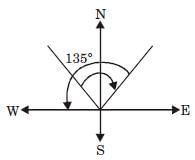
So, a man is facing west direction (from
fig.)
fig.)
Direction: Read the following information carefully and answer the questions given below:M, P, J, B, R, T and F are sitting around a circle facing the centre. B is the third to the left of J who is second to the left of M. P isthird to the left of B and second to the right of R. T is not an immediate neighbour of M.Who is fourth to the right of M?- a)B
- b)T
- c)J
- d)M
Correct answer is option 'A'. Can you explain this answer?
Direction: Read the following information carefully and answer the questions given below:
M, P, J, B, R, T and F are sitting around a circle facing the centre. B is the third to the left of J who is second to the left of M. P isthird to the left of B and second to the right of R. T is not an immediate neighbour of M.
Who is fourth to the right of M?
a)
B
b)
T
c)
J
d)
M
|
|
Ritu Saxena answered |
From given question
The arrangement is:
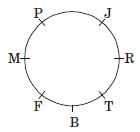
No option is correct, R is fourth to the right of M.
In a group of five persons Kamal is the tallest while Leela is the shortest. Rashi is shorter than Kamal but taller than Vinita and Priti. Priti is second shortest person in the group. Who is the third tallest?- a)Vinita
- b)Rashi
- c)Priti
- d)Leela
Correct answer is option 'A'. Can you explain this answer?
In a group of five persons Kamal is the tallest while Leela is the shortest. Rashi is shorter than Kamal but taller than Vinita and Priti. Priti is second shortest person in the group. Who is the third tallest?
a)
Vinita
b)
Rashi
c)
Priti
d)
Leela
|
|
Anoushka sengupta answered |
Given Information:
- Kamal is the tallest person in the group of five.
- Leela is the shortest person in the group.
- Rashi is shorter than Kamal.
- Rashi is taller than Vinita and Priti.
- Priti is the second shortest person in the group.
Solution:
To determine the third tallest person in the group, we need to analyze the given information step by step.
Step 1: Identify the tallest and shortest persons in the group.
- From the given information, we know that Kamal is the tallest person.
- Leela is the shortest person.
Step 2: Analyze the relationship between Kamal, Rashi, Vinita, and Priti.
- Rashi is shorter than Kamal.
- Rashi is taller than Vinita and Priti.
Step 3: Determine the position of Priti.
- Priti is the second shortest person in the group.
Step 4: Analyze the relationship between Kamal, Rashi, and Priti.
- Since Kamal is the tallest and Rashi is shorter than Kamal, it means Rashi is taller than Priti.
Step 5: Compare the heights of Leela and Rashi.
- Leela is the shortest person in the group.
- Rashi is taller than Priti, so Rashi is not the shortest person.
- Therefore, Leela is shorter than Rashi.
Step 6: Determine the position of Vinita.
- Since Priti is the second shortest person, it means Vinita is taller than Priti.
Step 7: Analyze the relationship between Rashi and Vinita.
- Rashi is taller than Vinita.
Conclusion:
- Kamal is the tallest person.
- Leela is the shortest person.
- Rashi is taller than Vinita, Priti, and Leela.
- Therefore, the third tallest person in the group is Vinita (option A).
- Kamal is the tallest person in the group of five.
- Leela is the shortest person in the group.
- Rashi is shorter than Kamal.
- Rashi is taller than Vinita and Priti.
- Priti is the second shortest person in the group.
Solution:
To determine the third tallest person in the group, we need to analyze the given information step by step.
Step 1: Identify the tallest and shortest persons in the group.
- From the given information, we know that Kamal is the tallest person.
- Leela is the shortest person.
Step 2: Analyze the relationship between Kamal, Rashi, Vinita, and Priti.
- Rashi is shorter than Kamal.
- Rashi is taller than Vinita and Priti.
Step 3: Determine the position of Priti.
- Priti is the second shortest person in the group.
Step 4: Analyze the relationship between Kamal, Rashi, and Priti.
- Since Kamal is the tallest and Rashi is shorter than Kamal, it means Rashi is taller than Priti.
Step 5: Compare the heights of Leela and Rashi.
- Leela is the shortest person in the group.
- Rashi is taller than Priti, so Rashi is not the shortest person.
- Therefore, Leela is shorter than Rashi.
Step 6: Determine the position of Vinita.
- Since Priti is the second shortest person, it means Vinita is taller than Priti.
Step 7: Analyze the relationship between Rashi and Vinita.
- Rashi is taller than Vinita.
Conclusion:
- Kamal is the tallest person.
- Leela is the shortest person.
- Rashi is taller than Vinita, Priti, and Leela.
- Therefore, the third tallest person in the group is Vinita (option A).
If A:B = 2:3, B:C = 2:4, and C:D = 2:5 then A:D is equal to- a)2:15
- b)2:5
- c)1:5
- d)3:5
Correct answer is option 'A'. Can you explain this answer?
If A:B = 2:3, B:C = 2:4, and C:D = 2:5 then A:D is equal to
a)
2:15
b)
2:5
c)
1:5
d)
3:5
|
|
Ritu Saxena answered |
The equired ratio of A : D is

If  , then what is the value of x?
, then what is the value of x?- a)–2
- b)–5
- c)–6
- d)–4
Correct answer is option 'D'. Can you explain this answer?
If  , then what is the value of x?
, then what is the value of x?
 , then what is the value of x?
, then what is the value of x?a)
–2
b)
–5
c)
–6
d)
–4
|
|
Ritu Saxena answered |
Given


squaring on both sides, we get

If the point (K, 2)is equidistant from the point (5, –2) and (1, –2) then value of K2 + 7 will be- a)10
- b)9
- c)12
- d)16
Correct answer is option 'D'. Can you explain this answer?
If the point (K, 2)is equidistant from the point (5, –2) and (1, –2) then value of K2 + 7 will be
a)
10
b)
9
c)
12
d)
16
|
|
Ritu Saxena answered |
Using distance formula

(k – 5)2 + (4)2 = (k – 1)2 + (4)2
⇒ (k – 5)2 – (k – 1)2 = 0
⇒ (k – 5)2 = (k –1 )2
⇒ k – 5 = |k–1|
⇒ k = 5 = –k + 1
∴ 2k = 6
⇒ k = ± 3
⇒ k2 + 7 = (± 3)2 + 7 = 16
In the given figure, how many triangles are there?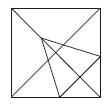
- a)26
- b)16
- c)18
- d)19
Correct answer is option 'D'. Can you explain this answer?
In the given figure, how many triangles are there?

a)
26
b)
16
c)
18
d)
19
|
|
Ritu Saxena answered |

The triangles are represented by C, D, E, H, K, M, AC, CD, BD, CF, DG, KM, EGK, CFK,DGM, MGH, ABCD, CDFG, ACFKE, EFKGHM and DGMBH.
So, 21 triangles.
Total number of triangles = 21
Find the angle between the two hands of a clock at 15 minutes past 4 O' clock (Minute hand and hour hand)- a)35.5°
- b)30°
- c)37.5°
- d)32.5°+
Correct answer is option 'C'. Can you explain this answer?
Find the angle between the two hands of a clock at 15 minutes past 4 O' clock (Minute hand and hour hand)
a)
35.5°
b)
30°
c)
37.5°
d)
32.5°+
|
|
Ritu Saxena answered |
At 4:15, angle between hands
= (4 × 30°) – (5.5 × 15°)
= 120° – 82.5
= 37.5°
So the angle between two hands of a clock is 37.5°.
Direction: Read the following information carefully and answer the questions given below:M, P, J, B, R, T and F are sitting around a circle facing the centre. B is the third to the left of J who is second to the left of M. P isthird to the left of B and second to the right of R. T is not an immediate neighbour of M.What is F’s position with respect to R?
(A) Third to the left
(B) Fourth to the right
(C) Third to the right- a)Only A
- b)Only B
- c)Only C
- d)Both A and B
Correct answer is option 'D'. Can you explain this answer?
Direction: Read the following information carefully and answer the questions given below:
M, P, J, B, R, T and F are sitting around a circle facing the centre. B is the third to the left of J who is second to the left of M. P isthird to the left of B and second to the right of R. T is not an immediate neighbour of M.
What is F’s position with respect to R?
(A) Third to the left
(B) Fourth to the right
(C) Third to the right
(A) Third to the left
(B) Fourth to the right
(C) Third to the right
a)
Only A
b)
Only B
c)
Only C
d)
Both A and B
|
|
Ritu Saxena answered |
From given question
The arrangement is:
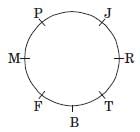
F is third to the left of R and fourth to the
right of R.
right of R.
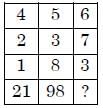
- a)85
- b)94
- c)49
- d)104
Correct answer is option 'B'. Can you explain this answer?

a)
85
b)
94
c)
49
d)
104
|
|
Ritu Saxena answered |
For Column-1
42 + 22 + 12 = 21
For Column-2
52 + 32 + 82 = 98
For Column-3

How many numbers between 10 and 90 are divisible by 8 completely- a)12
- b)10
- c)11
- d)8
Correct answer is option 'B'. Can you explain this answer?
How many numbers between 10 and 90 are divisible by 8 completely
a)
12
b)
10
c)
11
d)
8
|
|
Ritu Saxena answered |
Number between 10 and 90, which are divisible by 8.
First term (a) = 16
Last term (tn) = 88
∴ tn = a + (n – 1)d
88 = 16 + (n – 1)8
72 = (n – 1)8
∴ n = 1 + 9
= 10
Simplify
- a)

- b)

- c)1
- d)

Correct answer is option 'B'. Can you explain this answer?
Simplify

a)

b)

c)
1
d)

|
|
Ritu Saxena answered |
Given expression is





Select the figure from amongst the four alternatives which when placed in the blank space,would complete the pattern?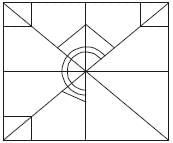
- a)

- b)

- c)

- d)

Correct answer is option 'C'. Can you explain this answer?
Select the figure from amongst the four alternatives which when placed in the blank space,would complete the pattern?

a)

b)

c)

d)

|
|
Ritu Saxena answered |
Answer fig. 3 will complete the given
pattern
pattern
A train cross a pole in 12 seconds. If the speed of the train is 54 km/hr then length of train will be- a)648 meter
- b)150 meter
- c)180 meter
- d)100 meter
Correct answer is option 'C'. Can you explain this answer?
A train cross a pole in 12 seconds. If the speed of the train is 54 km/hr then length of train will be
a)
648 meter
b)
150 meter
c)
180 meter
d)
100 meter
|
|
Ritu Saxena answered |
Here speed of the train
= 54 km/hr
= 54 km/hr

∴ Length of train
= speed of the tran × total time
= (15 × 12) m = 180 m
∴ The length of a train is 180 m
= speed of the tran × total time
= (15 × 12) m = 180 m
∴ The length of a train is 180 m
In the adjoining figure, ΔABC, is circumscribing a circle. Then the length of BC is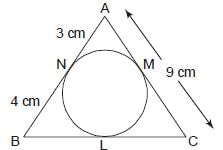
- a)10 cm
- b)7 cm
- c)9 cm
- d)8 cm
Correct answer is option 'A'. Can you explain this answer?
In the adjoining figure, ΔABC, is circumscribing a circle. Then the length of BC is

a)
10 cm
b)
7 cm
c)
9 cm
d)
8 cm
|
|
Ritu Saxena answered |

⇒ BC = 10 cm(Tangents from a point to the circle are of equal length)
The selling price of 5 articles is the same as the cost price of 3 article. The gain or loss percent is- a)25% gain
- b)30% gain
- c)40% loss
- d)33.33% loss
Correct answer is option 'C'. Can you explain this answer?
The selling price of 5 articles is the same as the cost price of 3 article. The gain or loss percent is
a)
25% gain
b)
30% gain
c)
40% loss
d)
33.33% loss
|
|
Ritu Saxena answered |
From given question
SP of 5 = CP of 3
5 SP = 3 CP


Value of (3.5)3 – (2.5)3 is- a)25.27
- b)29.25
- c)27.25
- d)25.29
Correct answer is option 'C'. Can you explain this answer?
Value of (3.5)3 – (2.5)3 is
a)
25.27
b)
29.25
c)
27.25
d)
25.29
|
|
Ritu Saxena answered |
(3.5)3 – (2.5)3
= (3.5 – 2.5) ((3.5)2 + (2.5)2 + 3.5 x 2.5)
= 1 x (12.25 + 6.25 + 8.75)
= 27.25
If sin A + cos A = √2 sin (90° – A) then value of ( √2+ 1) tan A will be- a)1
- b)0
- c)√2
- d)2
Correct answer is option 'A'. Can you explain this answer?
If sin A + cos A = √2 sin (90° – A) then value of ( √2+ 1) tan A will be
a)
1
b)
0
c)
√2
d)
2
|
|
Ritu Saxena answered |
Given sin A + cos A = √2 cos A
sin A = √2 cos A – cos A
sin A = ( √2 – 1) cos A
tan A = √2 – 1
( √2 + 1) tan A = ( √2 + 1)( √2 – 1)
( √2 + 1) tan A = 1
The sheet of paper shown in the figure is folded to form a box. Choose the correct alternative, which will truly represent the position of alphabets A to F shown in the following figure?
- a)

- b)

- c)

- d)

Correct answer is option 'B'. Can you explain this answer?
The sheet of paper shown in the figure is folded to form a box. Choose the correct alternative, which will truly represent the position of alphabets A to F shown in the following figure?

a)

b)

c)

d)

|
|
Ritu Saxena answered |
A ↔ D, C ↔ E, B ↔ F
∴ (2) will be formed.
∴ (2) will be formed.

- a)3/7
- b)2
- c)3
- d)4
Correct answer is option 'C'. Can you explain this answer?

a)
3/7
b)
2
c)
3
d)
4
|
|
Ritu Saxena answered |

(position of albhabet start from left)
Similarly

If in a certain language ‘how can you go’ is written as ‘je de ke pe’, ‘you come here’ is written as ‘ne ke se’ and ‘come and go’ as ‘re pe se’, then how will ‘here’ be written in the langauge?- a)je
- b)pe
- c)me
- d)ke
Correct answer is option 'A'. Can you explain this answer?
If in a certain language ‘how can you go’ is written as ‘je de ke pe’, ‘you come here’ is written as ‘ne ke se’ and ‘come and go’ as ‘re pe se’, then how will ‘here’ be written in the langauge?
a)
je
b)
pe
c)
me
d)
ke
|
|
Ritu Saxena answered |
From the given question code for the
language is given below.
you → ke, come → se
⇒ here → ne
language is given below.
you → ke, come → se
⇒ here → ne
Chapter doubts & questions for Delhi - NTSE for Class 10 2025 is part of Class 10 exam preparation. The chapters have been prepared according to the Class 10 exam syllabus. The Chapter doubts & questions, notes, tests & MCQs are made for Class 10 2025 Exam. Find important definitions, questions, notes, meanings, examples, exercises, MCQs and online tests here.
Chapter doubts & questions of Delhi - NTSE for Class 10 in English & Hindi are available as part of Class 10 exam.
Download more important topics, notes, lectures and mock test series for Class 10 Exam by signing up for free.

Contact Support
Our team is online on weekdays between 10 AM - 7 PM
Typical reply within 3 hours
|
Free Exam Preparation
at your Fingertips!
Access Free Study Material - Test Series, Structured Courses, Free Videos & Study Notes and Prepare for Your Exam With Ease

 Join the 10M+ students on EduRev
Join the 10M+ students on EduRev
|

|
Create your account for free
OR
Forgot Password
OR
Signup to see your scores
go up
within 7 days!
within 7 days!
Takes less than 10 seconds to signup





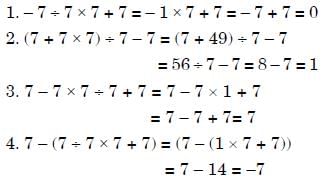
 is an arc of a circle of radius AB, what is the area of the shaded region?
is an arc of a circle of radius AB, what is the area of the shaded region?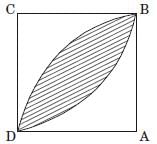
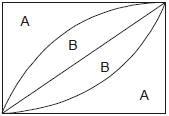

 then what will be the value of
then what will be the value of 



